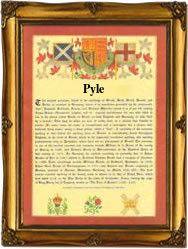This unusual name is of Anglo-Saxon origin, and is a topographical surname given in the first instances to someone who lived near a stake or post which had been placed to serve as a landmark or boundary marker. The derivation is from the Olde English pre 7th Century "pil", stake, post, from the Latin "pilum", spike, javelin, in Middle English "pile". Topographical surnames were among the earliest created, since both natural and man-made features in the landscape provided easily recognisable distinguishing names in the small communities of the Middle Ages. Early examples of the surname include: Robert Pile, in the Somersetshire Assize Court Rolls of 1243; Robert Attepile, in the Somerset Hundred Rolls of 1274; and Walter atte Pyle, listed in the Exchequer Lay Subsidy Rolls of 1327. The modern forms of the name are Pile or Pyle, and among the recordings in Church Registers are those of the christening of Alice Pile, at St. Andrew's, Holborn, London, on September 23rd 1561, and the marriage of Thomas Pile and Anne Bennett on January 30th 1590, in Clyst Hydon, Devonshire. A Coat of Arms granted to a family of the name depicts a red cross between four red nails on a silver shield. The first recorded spelling of the family name is shown to be that of Henry de la Pil, which was dated 1221, in the "Calendar of Patent Rolls of Somersetshire", during the reign of King Henry 111, known as "The Frenchman", 1216 - 1272. Surnames became necessary when governments introduced personal taxation. In England this was known as Poll Tax. Throughout the centuries, surnames in every country have continued to "develop" often leading to astonishing variants of the original spelling.
© Copyright: Name Origin Research 1980 - 2024

Enjoy this name printed onto our colourful scroll, printed in Olde English script. An ideal gift.
